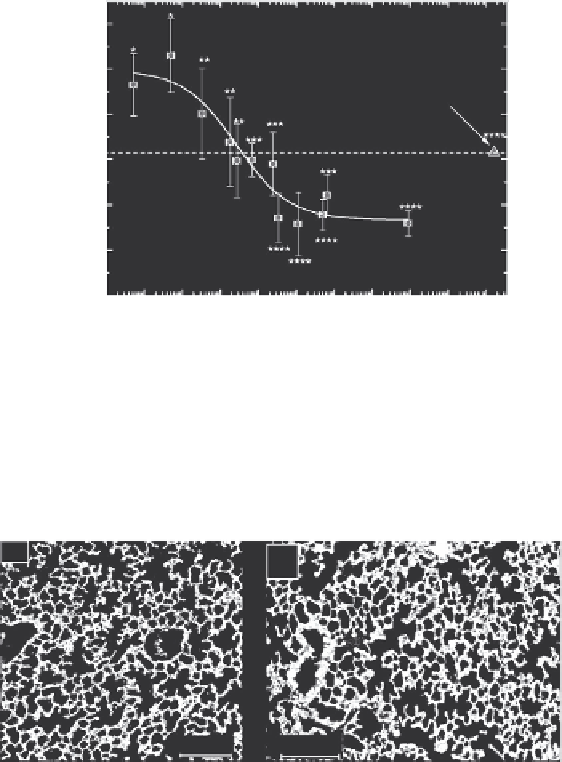Environmental Engineering Reference
In-Depth Information
1.2
5 nm
1.0
Peroral treatment
4 nm
21 nm
0.8
35 nm
16 nm
0.6
32 nm
12 nm
22 nm
24 nm
0.4
49 nm
37 nm
180 nm
0.2
0.0
10
-9
10
-8
10
-7
10
-6
10
-5
10
-4
10
-3
10
-2
10
-1
10
0
10
1
Lung deposited dose (mg/kg bw)
FIGURE 11.11
Mean REI versus the lung-deposited dose (circles). Bars indicate standard error. The par-
ticle mean diameter is shown at every point. The levels of statistical signiicance of differences of the edema
indexes between the aerosolized and untreated groups were calculated using Students
t
-test and are indicated
as *1 <
P
< 0.5, **0.5 <
P
< 0.05, ***0.05 <
P
< 0.001, ****
P
< 0.001. The itted dose-response curve is shown
as solid line. Triangle is REI for peroral treatment; this point is a mean value throughout six experimental tri-
als (each trial included groups of 8-10 animals).
(a)
(b)
100 µm
100 µm
FIGURE 11.12
Representative sections from the lungs of untreated animal (group 1) (a) and the animal
treated by the indometacin aerosol of
d
= 200 nm (group 3.1) (b).
In the case of ibuprofen treatment, the animals were exposed to nanoparticles of
d
= 100 nm,
with the lung-deposited dose of 5.5 × 10
−3
mg per kg bw (group 3.1, 16 animals), and
d
= 75 nm,
with the lung-deposited dose of 2.9 × 10
−3
mg per kg bw (group 3.2, 16 animals). A moderate
venous hyperemia was observed for seven animals from group 3.1 and for all the animals from
group 3.2 (Figure 11.15). The other nine animals of group 3.1 have demonstrated more pronounced
venous and arterial hyperemia (Figure 11.16). A homogeneous venous deposition (presumably
ibrin) was observed. Typical emphysematous signs occurred in the lungs of those animals, that
is, the dilatation of bronchioli and alveolar channels, alveolar wall thinning, and partial capillary
bed reduction.
11.1.3 c
onclusions
The anti-inlammatory action analgesic effect and side pulmonary effects caused by the inhala-
tion of indomethacin and ibuprofen nanoparticles, respectively, were investigated. To this end, an
evaporation-condensation system was developed which was able to generate aerosol nanoparticles
within the size range of 3 <
d
< 200 nm. The chromatographic analysis showed that the aerosol par-
ticles were chemically identical to the maternal substance (i.e., there was no thermal decomposition

Search WWH ::

Custom Search